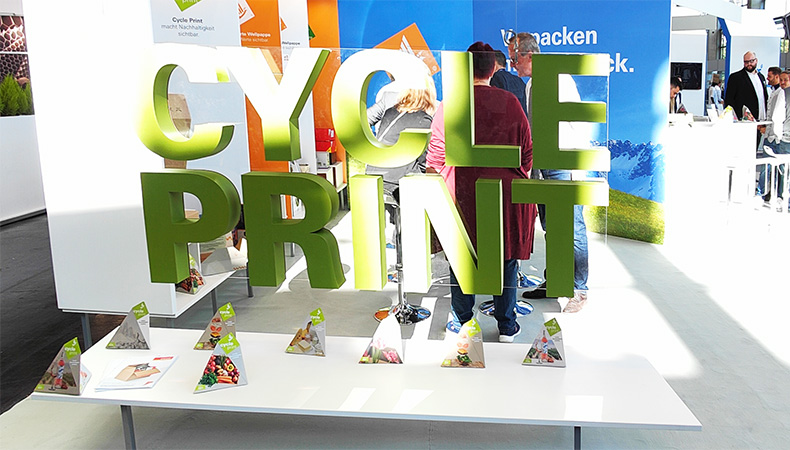How to print sustainably and protect the environment

Sustainability is a key factor when it comes to making new products. This also applicable to print products, but what does this mean for printers? Sonja Angerer discusses how printers can adapt to the new sustainable market?
The economic situation and the growing trend towards online shopping has affected the digital printing industry. Posters and any of the sort of wide format printing are rarely seen in many cities.
In addition, the consciousness on carbon footprint and sustainability has also impacted these ongoing changes. In 2016, as per the Federal Ministry for the Environment, Nature Conservation, Nuclear Safety and Consumer Protection, 250 kilogrammes of paper and cardboard were consumed in Germany per capita. Nearly 90% of this was created by graphic and office applications and packaging printing. This excludes the common plastic and textile printing substrates.
Consumers, particularly younger consumers, are less willing to buy into the wide format printing industry. The printing industry has had to urgently act and actively demonstrate that they can print more sustainably, protect the environment and remain relevant to their customers.
This article looks at 3 issues that printers can address so that they can print more sustainably:
- Substrates
- Production process
- Futureproofing
 CAPTION: The topic of sustainability is also taking up a lot of space in (digital) packaging printing. Photo: S. Angerer
CAPTION: The topic of sustainability is also taking up a lot of space in (digital) packaging printing. Photo: S. Angerer Sustainable use of substrates in printing
1. Buy right
Suggestion: Increase inventory and initiate collective orders with partnered companies where necessary. This reduces emissions and costs.
2. Build supply chains
Suggestion: Build relationships with reliable and local suppliers who can offer essentials at short notice and can prove their supply chains.
3. Choose material carefully
Suggestion: offer prints only on recycled materials or materials that can be recycled easily, reducing the number of substrates. This also results in lower waste.
4. Pay attention to recyclability
Suggestion: Print products should be redesigned from scratch so that they can be easily be recycled.
CAPTION: In many Central European countries, large posters have become a rare sight. Printers have not made enough of an effort to determine how they can print sustainability. Photo: S. Angerer
Sustainmability in the production process
1. Calculate power consumption
Suggestion: Consistently investing in energy efficient machines where possible and shutting down machinery that isn’t used for an extended period.
2. Refurbish building
Suggestion: Upgrade buildings, use LED light instead of neon, invest in fume extraction or recycling of solvents.
3. Not all electricty is made the same
Suggestion: Look for green electricity providers or install solar panels on the company roofs.
4. Avoid waste
Suggestion: Waste can be significantly reduced by combining several jobs on one substrate roll and improving nesting.
Sustainable management is important for the future
1. Thinking long-term instead of short-term profits
Suggestion: Long term customer loyalty and sustainable growth can only be achieved through reliable quality and good values.
2. The process is as important as the product
Suggestion: A blog, using social media accounts or frequently attending industry meetings gives a company credibility.
3. Be a considerate employer
Printers are finding it increasingly difficult to find qualified and skilled workers, junior or senior level. The large workload and unusual working hours that many companies require doesn’t help.
Suggestion: Instil an appreciative atmosphere, opportunities to progress and planned working hours make companies attractive and futureproof.
Conclusion: Sustainable printing is a must
For printers, sustainability is not only about the environment but about the existence of the entire industry. Sustainable businesses with a strong public presence will be the ones operating long-term.
Depending on their customer base and location, printers are dealing with the pressure to be sustainable at across different levels. To remain relevant, the industry must consider the efforts needed as a requirement to not only the individual printers but their customers and suppliers as well.
Main image caption: Photo: S. Angerer
Topics
Interested in joining our community?
Enquire today about joining your local FESPA Association or FESPA Direct
Recent news

Streamlining personalisation with tech: Insights from the SmartHub Conference 2025 speakers
Personalisation Experience 2025 (6 – 9 May 2025, Messe Berlin, Germany) is running its inaugural SmartHub Conference from 6 – 8 May 2025.

Special Effects in DTF: How Neon Inks Are Making Apparel Pop
Neon fluorescent inks are the latest innovation in DTF printing, offering vibrant, eye-catching effects under both daylight and UV light, giving apparel decorators a competitive edge. Testing shows good wash durability, though market perception of added value is still developing. With increasing adoption and ongoing technological advancements, neon represents a significant upgrade for creative customisation.

Unlocking Growth Opportunities in the Printed Personalised Apparel Industry
The printed personalised apparel industry is booming, projected to reach $10.1 billion by 2030. Driven by consumer desire for self-expression and branding needs, technological advancements like DTG/DTF and e-commerce integration are key. Sustainability, eco-friendly materials, and on-demand printing are crucial growth drivers. Businesses leveraging these trends, including AI and social media, have significant commercial potential.

How to grow your business with white ink applications
Opaque white ink is revolutionising signage, vehicle graphics, wallcoverings, short-run and wood packaging, and window blinds by enhancing vibrancy and clarity. This enables printers to offer high-demand, standout products, boosting profit margins. HP Latex white ink applications and their large format printing solutions will be showcased at FESPA 2025 in Berlin.